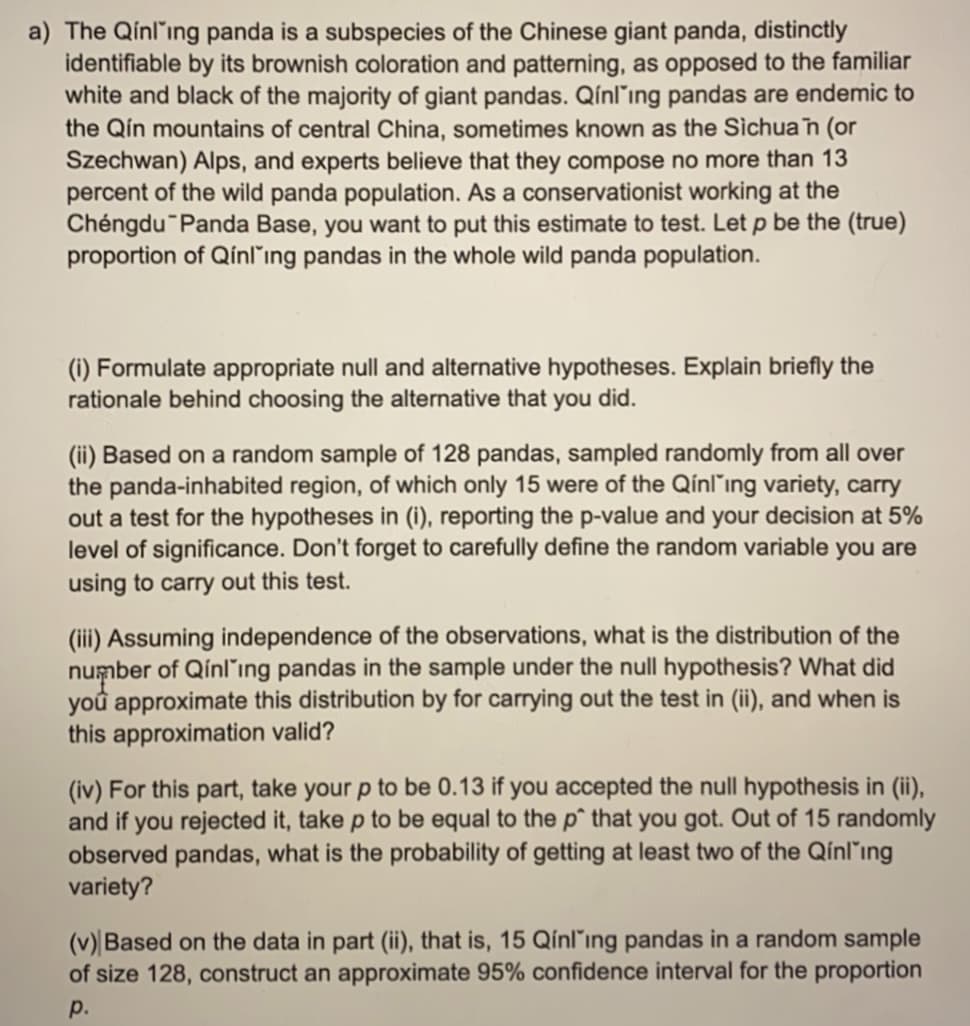a) The Qinl'ing panda is a subspecies of the Chinese giant panda, distinctly identifiable by its brownish coloration and patterning, as opposed to the familiar white and black of the majority of giant pandas. Qínl'ing pandas are endemic to the Qín mountains of central China, sometimes known as the Sichuan (or Szechwan) Alps, and experts believe that they compose no more than 13 percent of the wild panda population. As a conservationist working at the Chéngdu Panda Base, you want to put this estimate to test. Let p be the (true) proportion of Qínlıng pandas in the whole wild panda population. (i) Formulate appropriate null and alternative hypotheses. Explain briefly the rationale behind choosing the alternative that you did. (ii) Based on a random sample of 128 pandas, sampled randomly from all over the panda-inhabited region, of which only 15 were of the Qínl"ıng variety, carry out a test for the hypotheses in (i), reporting the p-value and your decision at 5% level of significance. Don't forget to carefully define the random variable you are using to carry out this test.
a) The Qinl'ing panda is a subspecies of the Chinese giant panda, distinctly identifiable by its brownish coloration and patterning, as opposed to the familiar white and black of the majority of giant pandas. Qínl'ing pandas are endemic to the Qín mountains of central China, sometimes known as the Sichuan (or Szechwan) Alps, and experts believe that they compose no more than 13 percent of the wild panda population. As a conservationist working at the Chéngdu Panda Base, you want to put this estimate to test. Let p be the (true) proportion of Qínlıng pandas in the whole wild panda population. (i) Formulate appropriate null and alternative hypotheses. Explain briefly the rationale behind choosing the alternative that you did. (ii) Based on a random sample of 128 pandas, sampled randomly from all over the panda-inhabited region, of which only 15 were of the Qínl"ıng variety, carry out a test for the hypotheses in (i), reporting the p-value and your decision at 5% level of significance. Don't forget to carefully define the random variable you are using to carry out this test.
Elements Of Modern Algebra
8th Edition
ISBN:9781285463230
Author:Gilbert, Linda, Jimmie
Publisher:Gilbert, Linda, Jimmie
Chapter1: Fundamentals
Section1.1: Sets
Problem 37E: Prove or disprove that AB=AC implies B=C.
Related questions
Question

Transcribed Image Text:a) The Qínl'ing panda is a subspecies of the Chinese giant panda, distinctly
identifiable by its brownish coloration and patterning, as opposed to the familiar
white and black of the majority of giant pandas. Qínl'ing pandas are endemic to
the Qín mountains of central China, sometimes known as the Sichua n (or
Szechwan) Alps, and experts believe that they compose no more than 13
percent of the wild panda population. As a conservationist working at the
Chéngdu Panda Base, you want to put this estimate to test. Let p be the (true)
proportion of Qínling pandas in the whole wild panda population.
(i) Formulate appropriate null and alternative hypotheses. Explain briefly the
rationale behind choosing the alternative that you did.
(ii) Based on a random sample of 128 pandas, sampled randomly from all over
the panda-inhabited region, of which only 15 were of the Qínl"ing variety, carry
out a test for the hypotheses in (i), reporting the p-value and your decision at 5%
level of significance. Don't forget to carefully define the random variable you are
using to carry out this test.
(iii) Assuming independence of the observations, what is the distribution of the
number of Qínl'ıng pandas in the sample under the null hypothesis? What did
you approximate this distribution by for carrying out the test in (ii), and when is
this approximation valid?
(iv) For this part, take your p to be 0.13 if you accepted the null hypothesis in (ii),
and if you rejected it, take p to be equal to the p^ that you got. Out of 15 randomly
observed pandas, what is the probability of getting at least two of the Qínling
variety?
(v) Based on the data in part (ii), that is, 15 Qínl'ing pandas in a random sample
of size 128, construct an approximate 95% confidence interval for the proportion
p.
Expert Solution
This question has been solved!
Explore an expertly crafted, step-by-step solution for a thorough understanding of key concepts.
Step by step
Solved in 3 steps with 2 images

Knowledge Booster
Learn more about
Need a deep-dive on the concept behind this application? Look no further. Learn more about this topic, statistics and related others by exploring similar questions and additional content below.Recommended textbooks for you

Elements Of Modern Algebra
Algebra
ISBN:
9781285463230
Author:
Gilbert, Linda, Jimmie
Publisher:
Cengage Learning,

Elements Of Modern Algebra
Algebra
ISBN:
9781285463230
Author:
Gilbert, Linda, Jimmie
Publisher:
Cengage Learning,